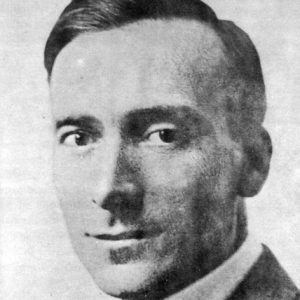calsfoundation@cals.org
William Lee Cazort (1887–1969)
William Lee Cazort was a familiar figure in Arkansas politics throughout the 1920s and 1930s. He served several terms in the state legislature and three times as lieutenant governor, but his political ambitions were checked by three unsuccessful gubernatorial bids.
The scion of a prominent local family, Lee Cazort was born on December 3, 1887, near Cabin Creek (now Lamar) in Johnson County. He was the son of Belle Gardner and John Robert Cazort. His father was invested in interests as diverse as land, lumber, livestock, cotton, and mercantile trade. Popularly known as Cazort Brothers, the family business was a virtual empire that operated throughout Arkansas and into neighboring states.
Cazort grew up in a household of eight children. He went to public school in Lamar and finished high school in Fort Smith (Sebastian County). He attended Hendrix College in Conway (Faulkner County) from 1903 to 1904 and the University of Arkansas (UA) in Fayetteville (Washington County) in 1907. In 1910, Cazort received a law degree from Washington and Lee University in Lexington, Virginia. He returned home to practice law in Fort Smith and to manage his orchards on Big Danger Mountain in Johnson County. He married Rachel Cline of Newton County on December 1, 1916. They had four children.
In 1915, Cazort was elected to represent Johnson County in the Arkansas House of Representatives. That year, he introduced the Tick Eradication Act and later sponsored an act to provide free textbooks for the first eight grades in Arkansas public schools. In 1917, he became House speaker.
In 1919, Cazort was elected to represent Johnson and Pope counties in the state Senate. He sponsored a resolution supporting women’s suffrage as the Nineteenth Amendment was being considered in the U.S. Senate. In 1921, he served as president of the state Senate.
In his day, Cazort was the youngest man to have served in the General Assembly as speaker of the House (age twenty-nine) and later as president of the Senate (age thirty-three). Cazort attracted the attention of James A. Comer, the Exalted Cyclops and Grand Dragon of the state Ku Klux Klan (KKK). With the support of Comer’s corrupt political machine, Cazort sought the 1924 Democratic gubernatorial nomination as the Klan candidate. This caused a stir among the other candidates, as many also claimed to be avid Klansmen. The Klan vote was split. Cazort placed second in a field of six, losing to Tom J. Terral. His defeat weakened Comer’s leadership and heralded the decline of the Klan’s influence on Arkansas politics in the late 1920s.
Cazort bided his time serving as a member of the Penitentiary Commission (1927–1928). In 1928, he was elected lieutenant governor and, in 1929, moved to Little Rock (Pulaski County). He succeeded Harvey Parnell, who was elected governor. The two did not have an amicable working relationship, in part because of competitive political ambitions. Parnell reputedly refused to attend President Herbert Hoover’s drought conference in August 1930 because he did not want to leave Cazort as acting governor.
Cazort did not seek reelection as lieutenant governor in 1930. Instead, he made a second bid for the Democratic gubernatorial nomination. Running a campaign sharply critical of Parnell’s control of state finances, Cazort charged the governor with cronyism in his selection of highway commissioners. Cazort later withdrew from the race and supported the candidacy of Brooks Hays. Afterward, Cazort returned to practicing law in Little Rock, where he specialized in representing World War I veterans in insurance claims.
In 1932, Cazort won a second term as lieutenant governor and was reelected unopposed in 1934. As acting governor, he announced the appointment of an honorary commission celebrating Arkansas’s 100th anniversary. In 1937, Governor Junius Marion Futrell appointed Cazort to the newly formed Public Welfare Commission. Futrell’s commission had been under criticism for its poorly conceived implementation. Three days later, Cazort tendered his resignation. He stated that his duties as the presiding officer of the Senate would hinder his ability to serve fully as a member on the commission.
As the 1936 Democratic gubernatorial campaign was underway, Cazort wooed the electorate again. He withdrew three weeks before the primary in favor of Carl E. Bailey, who was elected. This was the last time Cazort ran for office.
In 1937, he was appointed federal referee in bankruptcy for the Eastern District of Arkansas; subsequently his duties expanded to encompass all three federal court districts in the state. He held this position until he retired in 1964.
Cazort died on October 6, 1969, in a Little Rock hospital. He is buried in Oakland Cemetery in Little Rock.
For additional information:
Alexander, Charles C. “Defeat, Decline, Disintegration: The Ku Klux Klan in Arkansas, 1924 and After.” Arkansas Historical Quarterly 22 (Winter 1963): 311–331.
Cazort, William Lee. “Radio address of Lee Cazort, candidate for governor, giving startling information concerning political conditions in Arkansas.” Special Collections. University of Arkansas Libraries, Fayetteville, Arkansas.
May Hope Moose Papers. Special Collections. University of Arkansas Libraries, Fayetteville, Arkansas.
Geoffery L. Stark
University of Arkansas, Fayetteville







Comments
No comments on this entry yet.